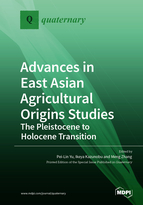Advances in East Asian Agricultural Origins Studies: The Pleistocene to Holocene Transition
A special issue of Quaternary (ISSN 2571-550X).
Deadline for manuscript submissions: closed (15 June 2020) | Viewed by 36449
Special Issue Editors
Interests: horticulture; ethnoarchaeology; Taiwan; Neolithic SE Asia
Special Issues, Collections and Topics in MDPI journals
Interests: hunter-gatherers; sedentarization; social changes; beads
Special Issues, Collections and Topics in MDPI journals
Interests: lithic technology; hunter-gatherer archaeology & anthropology; ethnoarchaeology; Chinese archaeology & anthropology; modernization in China; visual anthropology
Special Issues, Collections and Topics in MDPI journals
Special Issue Information
Dear Colleagues,
Scientific understanding about domestication and the origins of food production in East Asia is undergoing rapid change based on new data from archeology, paleobiology, and paleoenvironmental studies. The earliest agricultural and pastoral societies emerged from the highly diverse habitats and Paleolithic cultures of East Asia. This offers an unprecedented opportunity to understand and predict variability in the tempo and mode of the Paleolithic to Neolithic transition. Advances in East Asian Agricultural Origins Studies: The Pleistocene to Holocene Transition aims to present the most advanced research from the varied regions of East Asia, with the purpose of evaluating the significance of Paleolithic cultural influences on the transition to Neolithic adaptations by comparing cultural evolutionary scenarios through time and across space. The array of approaches will be multidisciplinary, featuring quantitative, qualitative, and integrated data and methodologies. Understanding the transition from foraging to Neolithic agriculture, which was among the most dramatic and influential in the history of modern Homo sapiens, has ramifications for the study of the Late Quaternary growth of human populations, societal complexity, landscape use, migration, and impacts on ecosystems.
Dr. Pei-Lin Yu
Prof. Dr. Ikeya Kazunobu
Dr. Meng Zhang
Guest Editors
Manuscript Submission Information
Manuscripts should be submitted online at www.mdpi.com by registering and logging in to this website. Once you are registered, click here to go to the submission form. Manuscripts can be submitted until the deadline. All submissions that pass pre-check are peer-reviewed. Accepted papers will be published continuously in the journal (as soon as accepted) and will be listed together on the special issue website. Research articles, review articles as well as short communications are invited. For planned papers, a title and short abstract (about 100 words) can be sent to the Editorial Office for announcement on this website.
Submitted manuscripts should not have been published previously, nor be under consideration for publication elsewhere (except conference proceedings papers). All manuscripts are thoroughly refereed through a single-blind peer-review process. A guide for authors and other relevant information for submission of manuscripts is available on the Instructions for Authors page. Quaternary is an international peer-reviewed open access quarterly journal published by MDPI.
Please visit the Instructions for Authors page before submitting a manuscript. The Article Processing Charge (APC) for publication in this open access journal is 1600 CHF (Swiss Francs). Submitted papers should be well formatted and use good English. Authors may use MDPI's English editing service prior to publication or during author revisions.
Keywords
- plant domestication
- food production
- agricultural and pastoral societies
- cultural evolution
- Late Quaternary
- East Asia








